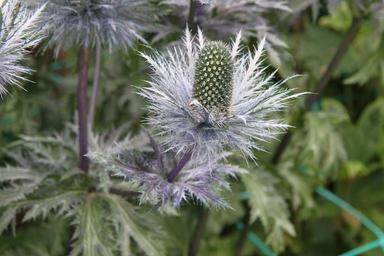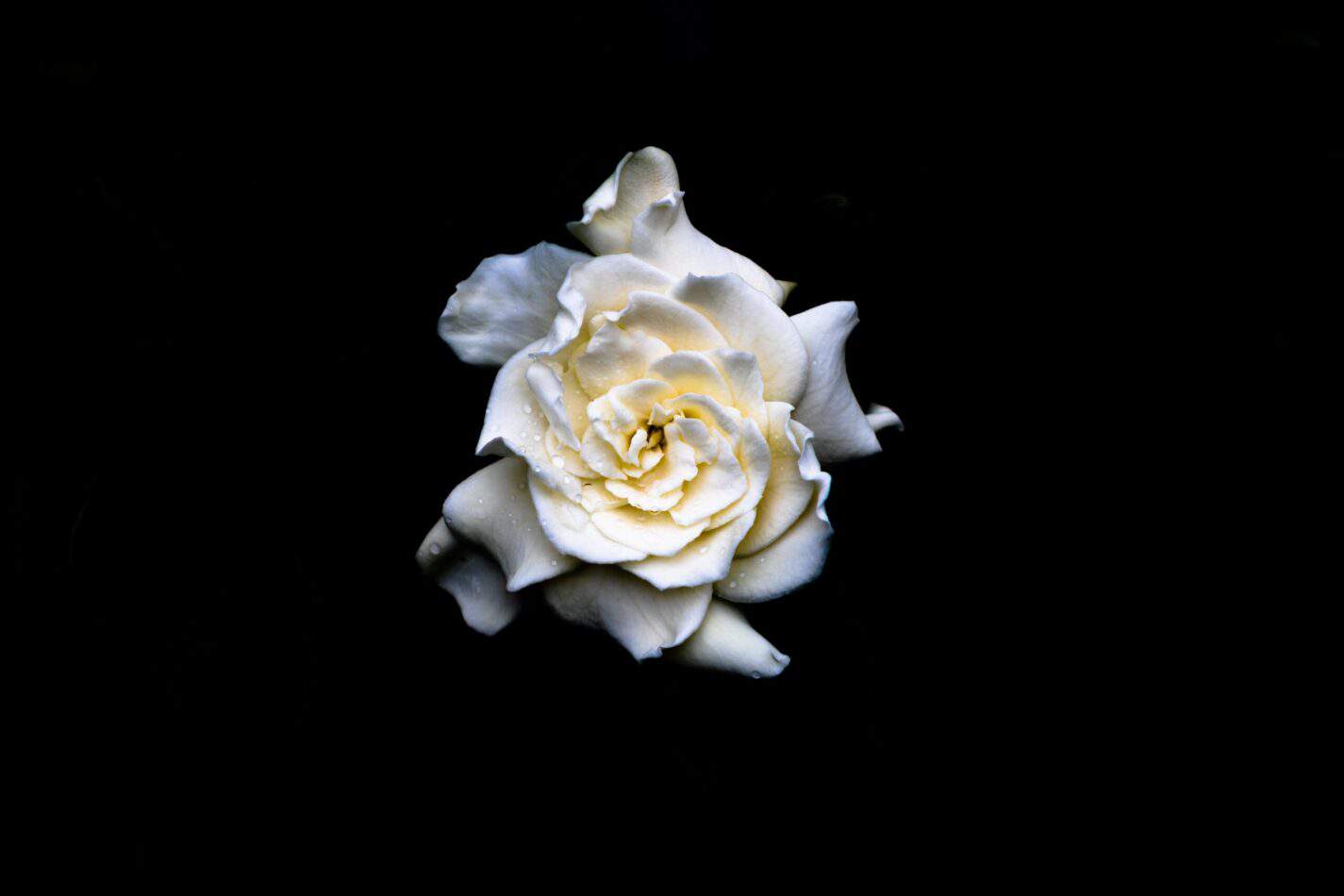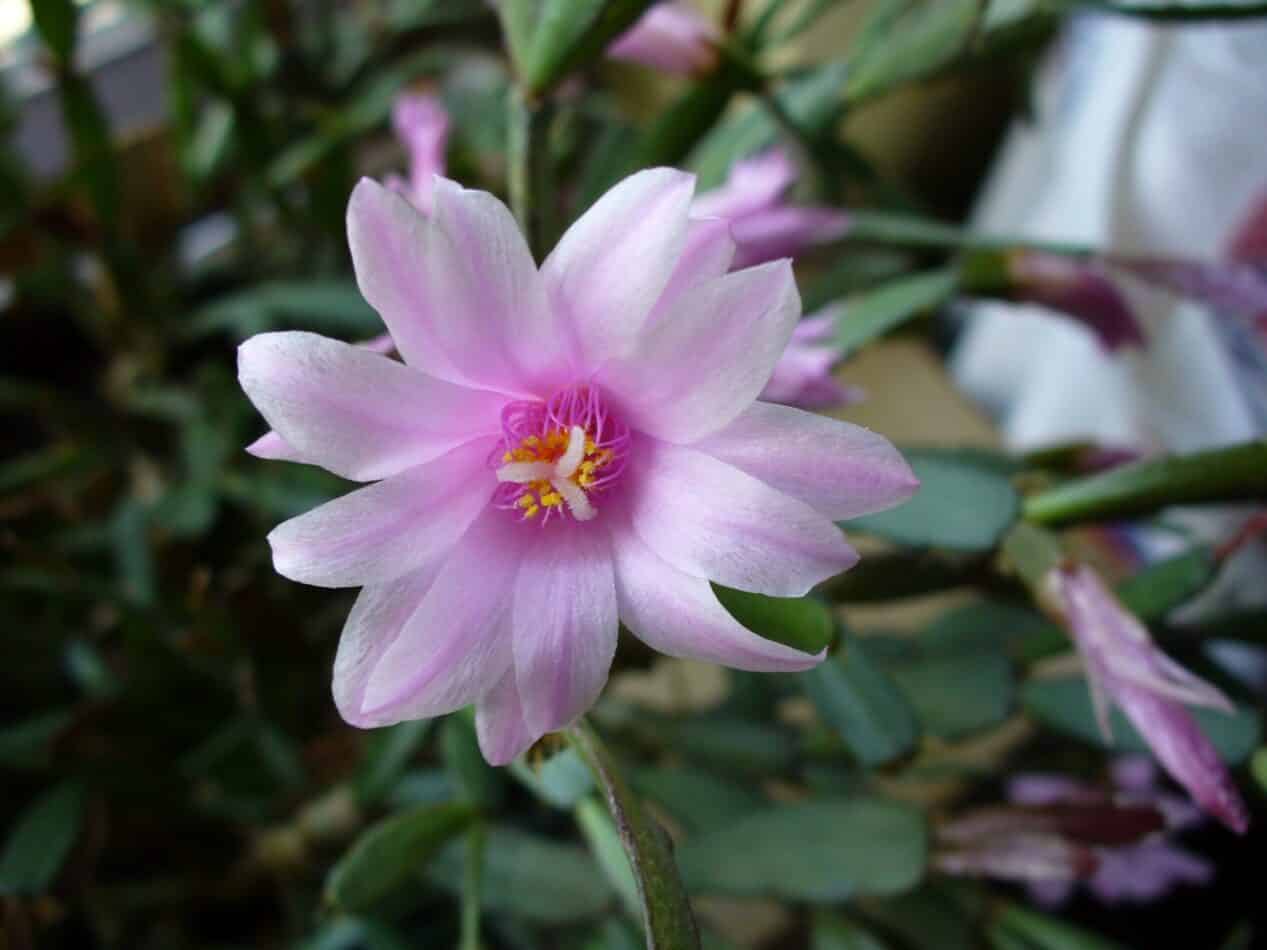Miss Willmotts Ghost, Eryngium giganteum, is an unusual-looking flowering plant that looks fantastic standing against other brightly colored flowers. The egg-shaped flower head is densely packed with tiny flowers that begin as pale green, gradually changing to steel-blue. The head is surrounded by spikey silver to white bracts, adding a ghosty feel to any landscape. It is an RHS winner, and it is drought tolerant.
Etymologically, the Latin name ‘Eryngium’ refers to the genus of plants to which Miss Willmotts Ghost belongs, and ‘giganteum’ describes this flower’s large size. Miss Willmotts Ghost belongs to the Apiaceae family and is classified as a perennial plant.
How to Plant
Miss Willmotts Ghost can be planted as early as March and as late as October. It is best to plant them in a sunny location as they need a minimum of six hours of sun a day. Soil should be loose but well-drained, with a pH range between 6.2 and 6.8. When planting, dig a hole twice as wide as the root ball and deep enough so that the crown of the plant is at ground level. Backfill the hole with the removed soil and press down lightly. Water the plant regularly for the first few weeks to make sure that it’s completely moist. Make sure to avoid overwatering and keep an eye out for any signs of diseases or pests.
Meaning & Symbolism
The flower’s strong association with death, doom, and fear has led to it being embraced by some cultures as a representation of mortality or a reminder that life is brief and valuable. In other cultures, it has been considered a symbol of protection, beauty, and mystery. Miss Willmotts Ghost has a range of symbolic meanings based on where it’s found and in history its lore. For example, in some cultures, it’s associated with the afterlife, while others know it as a harbinger of peace and harmony. For many, the sight of this gorgeous flower is a reminder of the simple joys of life.
History, Mythology, & Religious Significance
Miss Willmotts Ghost has a rich, somewhat mysterious history that has captured people all over the world. In folkloric beliefs, the ghostly flower was once thought to have descended from the sky, heralding the coming of spirits and the peace that follows. In Japan, it was believed to ward off evil, while in certain Christian traditions, it was regarded as an emotionless being, a signal that the nature of death is inevitable and falling asleep—like a ghost. In many cultures and religions, this flower has come to symbolize the power of life and death, mutability, and protection from harm.
Flower Varieties and Their Defining Characteristics
There are several varieties of Miss Willmotts Ghost that are distinct in size and shape. Some of the most popular varieties of Miss Willmotts Ghost include ‘Wayne’s Silver’ and ‘Festival White’. ‘Wayne’s Silver’ has a larger flower head, reaching up to 80 cm (31 in) in height. Its flower heads are steel-gray in color with dark violet bracts and have a more red hue than the other varieties. ‘Festival White’, on the other hand, reaches a maximum height of 60 cm (24 in) and has white flower heads framed by steel-gray bracts.
How to Pot and Repot
Before planting, select a pot that can drain freely, as this plant has a tendency to develop root rot if the soil remains wet. Choose a pot that’s two to three times wider than the root ball due to this plant’s heavy rooting habit. Fill the pot with a mixture of soil, compost, peat moss and sand to ensure good drainage. When planting, carefully place the root ball into the pot and slowly fill the pot with potting soil. Press the soil down firmly and water the plant. Place the pot in an area that gets indirect sunlight, such as an area near a window.
How to Prune
Miss Willmotts Ghost should be pruned in the late autumn and spring seasons. Pruning should be done with a sharp pair of shears, taking care not to damage the plant. Prune away any dead or diseased foliage or stems and any shoots that are growing away from the desired shape. Once the plant has reached the desired size and shape, use a pair of hand clippers to remove any unnecessary stems back to the base. Additionally, once the flowering period has finished, you can prune the flower heads right back to the lowest leaves.
How to Propagate
Propagating Miss Willmotts Ghost using seed can be done in the late summer or early autumn months. Take the mature seed heads of the plant and strip off the seed covers. Plant each seed in a peat pot with well-draining soil. Place the pot out of direct sunlight and keep it very moist. The seeds should take about four weeks to germinate. Once the seedlings have grown for four weeks, you can then transplant them into slightly bigger pots, making sure to keep them in indirect sunlight and keep the soil moist.
Common Pests & Diseases
Miss Willmotts Ghost can be affected by several pests and diseases, such as aphids, whiteflies, root rot, and powdery mildew. To prevent these issues, it is important to keep the plant in an area with good air flow, out of direct sunlight, and avoid overwatering. You should also make sure to use good potting soil, with plenty of added peat moss or perlite. Additionally, applying some insecticidal soap solution or neem oil to the leaves can help keep the aphids away. If the plant develops a disease, you may need to discard the plant and the soil, in order to prevent the spread of the disease to other plants.
Frequently Asked Questions
Q: Does Miss Willmotts Ghost need a lot of light?
A: Miss Willmotts Ghost needs six hours of direct sunlight per day.
Q: What types of soil does Miss Willmotts Ghost prefer?
A: Miss Willmotts Ghost prefers well-draining, sandy soils with a slightly acidic pH of 6.2-6.8.
Q: How often should I water Miss Willmotts Ghost?
A: Miss Willmotts Ghost should be watered regularly, allowing the top couple of inches of soil to dry out between each watering session.
Fact Sheet
| Flower | Description |
|---|---|
| Miss Willmotts Ghost, Eryngium giganteum | Apiaceae, Perennial |
| Mature Size | Up to 80 cm (31 in) |
| Sun Exposure | Full sun (6-8 hours/day) |
| Soil Type | Well-draining, sandy soil |
| Soil pH | 6.2-6.8 (slightly acidic) |
| Bloom Time | Late summer to early autumn |
| Flower Color | Pale green to steel-blue |
| Hardiness Zones | 4-8 |
| Native Area | Indigenous to Central and South America, West Africa, and Southern Europe |
What we love from Amazon this week
Buy these wonderful flowers directly from Amazon:















